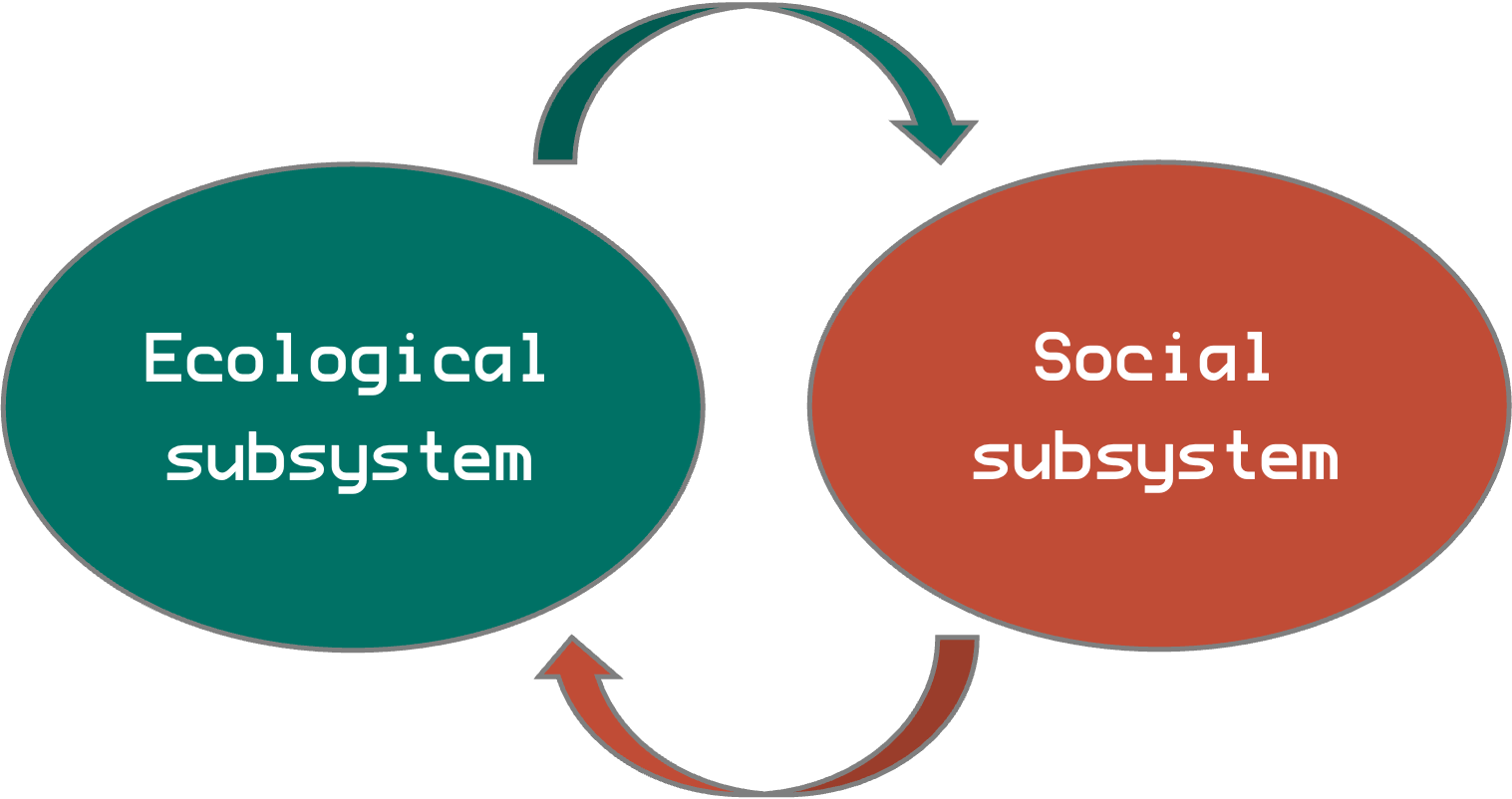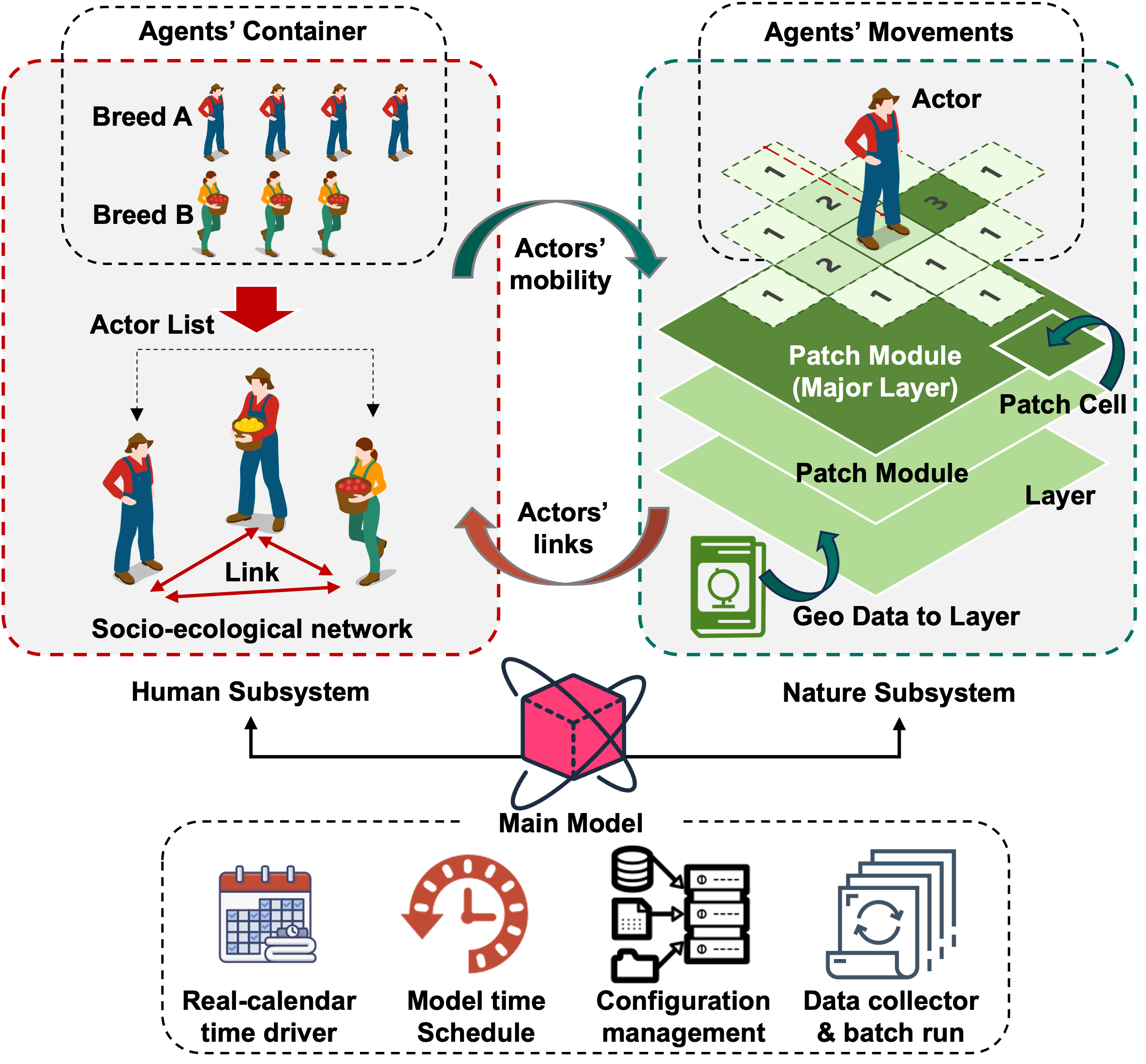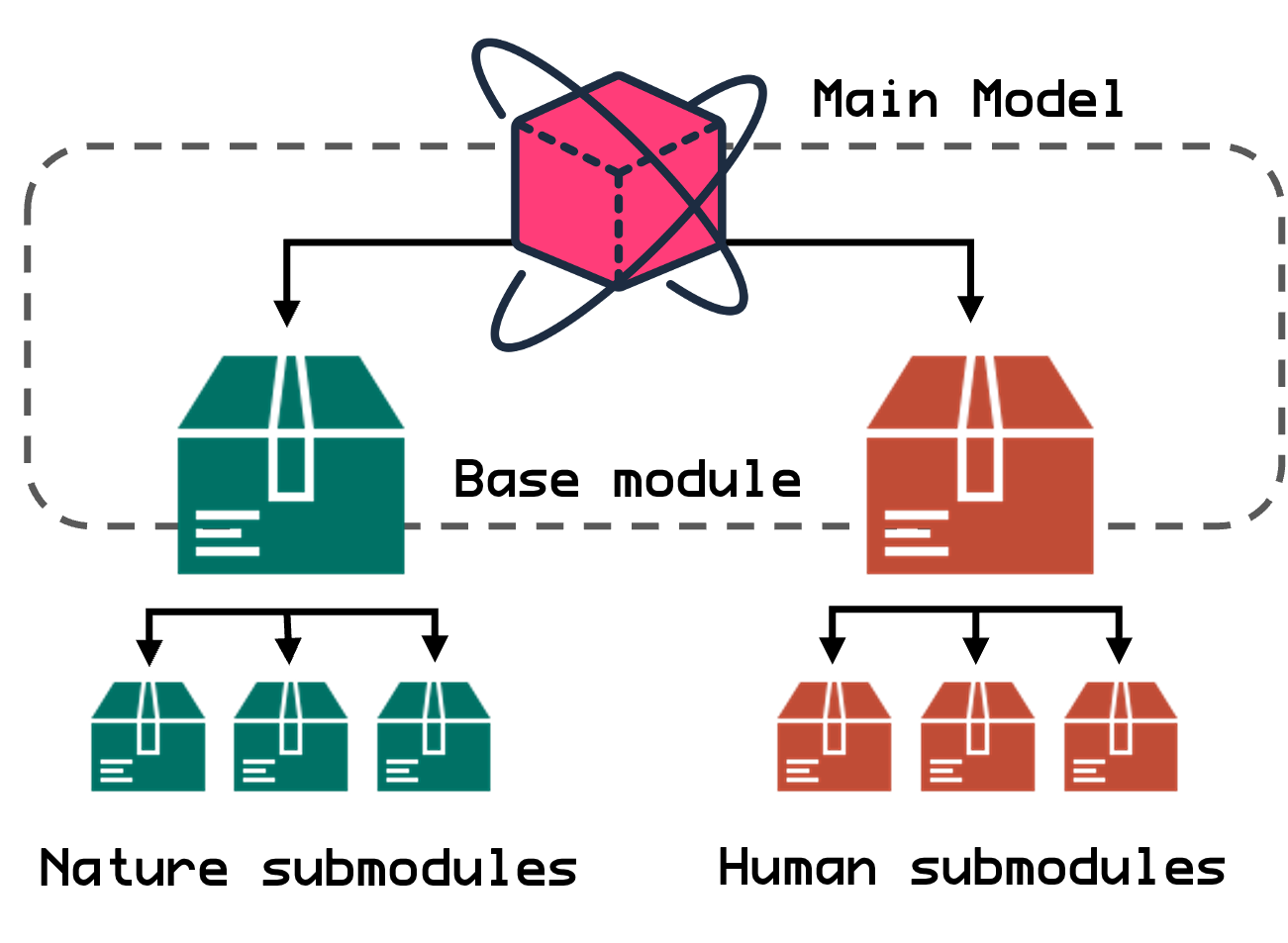Getting started
Introduction¶
ABSESpy has been designed to be a flexible and easy-to-use framework for agent-based modeling (ABM) of social-ecological systems (SES). It is built on top of the Mesa framework, which is a popular ABM framework in Python. ABSESpy provides a set of tools and utilities to help users to build, run, and analyze ABM models of SESs.
This getting-started tutorial help you to run the simplest workflow with ABSESpy framework. If you have agent-based modeling experience and prefer to learn using ABSESpy by examples, you can check out the official examples.
Following diagram shows the basic structure of the ABSESpy's API. Take it easy, you don't have to be familiar with all the features in this beginning stage. You can always go to the API documentation page to find a specific feature.
Get ABSESpy model running¶
Assuming you've successfully installed ABSESpy, along with all its dependencies, and properly configured the environment to import the module into your workspace. Running the first blank model that performs no action is straightforward - simply import, initialize, and run...
from abses import MainModel
model = MainModel()
model.run_model(steps=3) # How many steps to run
Warning
Without the arg steps, .run_model will run indefinitely unless stopped manually. Unless the ending condition can be found in the configurations.
Custom the basic modules¶
As the name "socio-ecological system" suggests, it usually includes two basic subsystems: social subsystem and ecological subsystem. Each of these subsystem has multiple processes, and a specific model can only care some of them according to the settings.
ABSESpy translates the structure into two modules: human and natural.
Each of the two modules can attach a set of sub-modules for simulating specific processes (This usually needs to be included based on practical issues and expertise).
Info

Structures of ABSESpy mimic the basic structure of a social-ecosystem system (SES) (1).
- More information of SES can be learned in the wiki pages.
Therefore, the default model MainModel provided by ABSESpy has BaseNature and BaseHuman as the two basic modules. They can be accessed through attributes human and nature.
Example
Users can custom the modules by inheriting BaseNature, BaseHuman, and MainModel from the three basic Components (1).
ABSESpyuses the term "Component" representing the modules, including not onlyBaseNatureandBaseHuman, but also the sub-modules attached withBaseNatureandBaseHuman.
Generally, each users are four methods can
Example
from abses import MainModel
# Import the custom modules.
from human import CustomHuman
from nature import CustomNature
model = MainModel(human_class=Human, nature_class=Nature)
model.run_model(steps=3) # How many steps to run
# output
>>> Setup the nature module.
>>> Setup the human module.
>>> Nature in the step 0.
>>> Human in the step 0.
>>> Nature in the step 1.
>>> Human in the step 1.
>>> Nature in the step 2.
>>> Human in the step 2.
>>> End of the nature module.
>>> End of the human module.
from abses import BaseHuman
class CustomHuman(BaseHuman):
"""A custom Human module.
"""
def initialize(self):
print("Initializing the human module.")
def setup(self):
print("Setup the human module.")
def step(self):
print(f"Human in the step {self.time.tick}.")
def end(self):
print("End of the human module.")
from abses import BaseNature
class CustomNature(BaseNature):
"""A custom Nature module.
"""
def initialize(self):
print("Initializing the nature module.")
def setup(self):
print("Setup the nature module.")
def step(self):
print(f"Nature in the step {self.time.tick}.")
def end(self):
print("End of the nature module.")
The following project structure is recommended for maintaining:
rootis the project directory.srccontains all the source codebase.model.pyis your model.- In the
human.py, custom logics of the social subsystem. - In the
nature.py, custom logics of the eco-subsystem.
In the above example, we customize the two components Nature and Human, then import them from source to be used as args for the model.
We wrote four different methods for each component:
initialize: called when the model is initialized.setup: called when the model is going to start running.step: called in the each time step of the model.end: called when the model has finished running.
Create and manage agents¶
Agent-based model means, some actors will be included in the artificial SES. ABSESpy provides an AgentsContainer to store and manage the agents, which can be accessed through the attribute model.agents. Under the context of SES, an agent sometimes is also called a social Actor (1). For creating such actors, we need to import the class Actor, which can also be customized by inheriting.
- social actor - who is not only influenced by the system, but also has motility to make decisions for changing the system
from abses import Actor, MainModel
class MyActor(Actor):
"""A customized actor"""
def say_hi(self) -> str:
print(f"Hello, world! I'm a new {self.breed}!")
model = MainModel()
actors = model.agents.new(Actor, 5)
my_actor = model.agents.new(MyActor, singleton=True)
my_actor.say_hi()
print(model.agents)
# output
>>> "Hello, world! I'm a new MyActor!"
>>> "<AgentsContainer: (5)Actor; (1)MyActor>"
In the above example, we customize the new breed (1) of actor -MyActor.
Then, we created five default Actor instances and one MyActor instance. All of the instances are stored in the AgentsContainer and attached to the model, so that users can access, add, delete, query, and change agents anytime they need through the AgentsContainer.
- By default, breed of an agent is just it's class name. User can change this behavior by overriding
breedclass property.
Configuration of the model¶
As you would have expected, modeling a real-world SES is far more complex than the example codes above. Luckily, one of the zens of ABSESpy is to separate the configuration and the model logic. As long as we configure it as follows, you will find that the ABSESpy framework is suitable for modeling of any complexity:
from abses import MainModel, Actor
class MyModel(MainModel):
"""Customized model."""
def setup(self):
n_agents = self.params.get('init_agents')
self.agents.new(Actor, n_agents)
def step(self):
n_agents = self.params.get('n_agents')
self.agents.new(Actor, n_agents)
def end(self):
n_agents = len(self.agents)
print(f"In {self.time}, there are {n_agents} actors.")
# A nested dictionary of parameters
parameters = {
'time': {'start': '2000-01-01', 'end': '2003-03-21', 'months': 8, 'years': 2},
'model': {'init_agents': 5, 'n_agents': 1}
}
# Initialize the model and run it.
model = MyModel(parameters=parameters)
model.run_model()
Not scared by these parameters, are you? Things are very simple:
MainModelaccepts a nested dictionary as parameters.- In the parameters,
timedescribes the time start/step/end rules, whilemodelprovided two parameters which can be parsed by the model. - In the
timesection,start = '2000-01-01'means when the model start to run, it mimic the day on 01th Jan. 2000. Similarly,end = '2003-03-21'means when the model time reach the day on 21th March 2003. Each time step simulates two years and eight months because of two parameters:months = 8andyears = 2. - According to the the customized functions
setup, the model will add some initial actors based on the parameterinit_agentsprovided. Similarly, the customized functionsstep, the model will add some actors in each step based on the parametersn_agents. - Okay! Elementary math time! When will the running model should be end? How many actors will be there when it ends?
Tip
You don't have to worry about writing a long long nested dictionary for the parameters in practice. ABSESpy allows users to easily manage complex parameters by using configuration files.
What to do for the next¶
Congratulations! So far, you have become familiar with the main concepts of the ABSESpy framework and know how to run a model.
We encourage you to return to our Guide Checklist, find out the feature or example model which most attractive to you.
Once you've decide to develop your own ABM by using ABSESpy, our well-organized API documentation should be a good reference. We also have detailed tutorials for users from different levels, happy coding!

